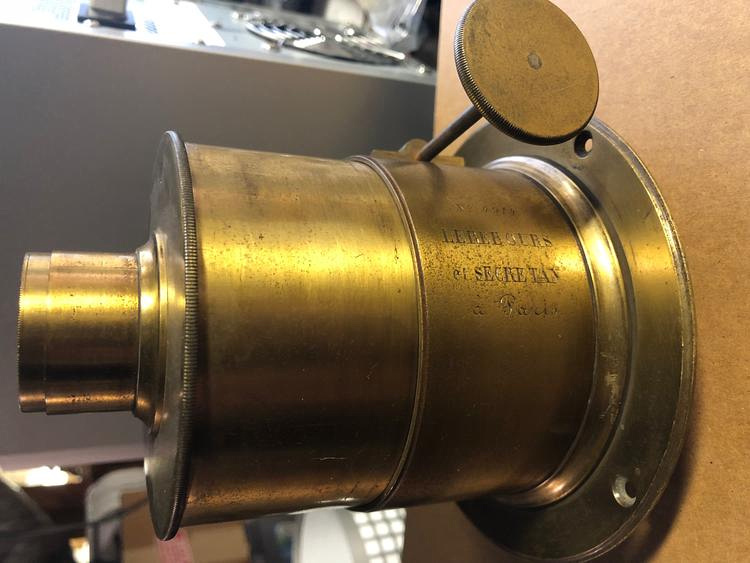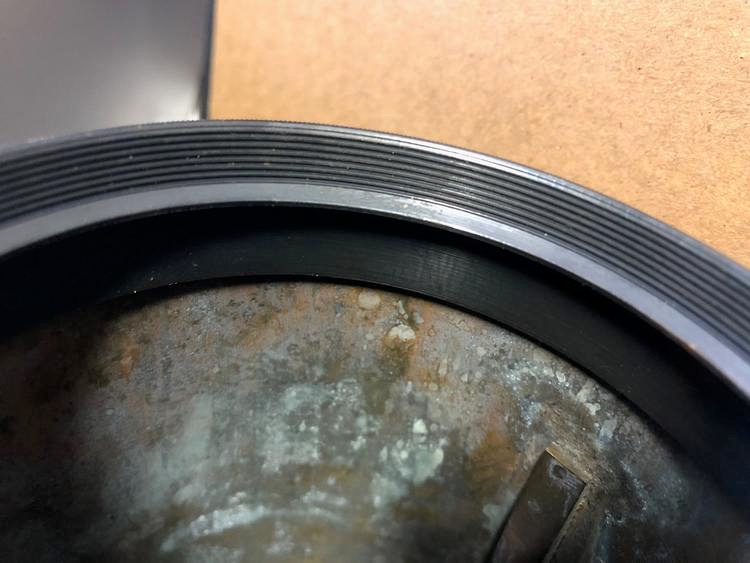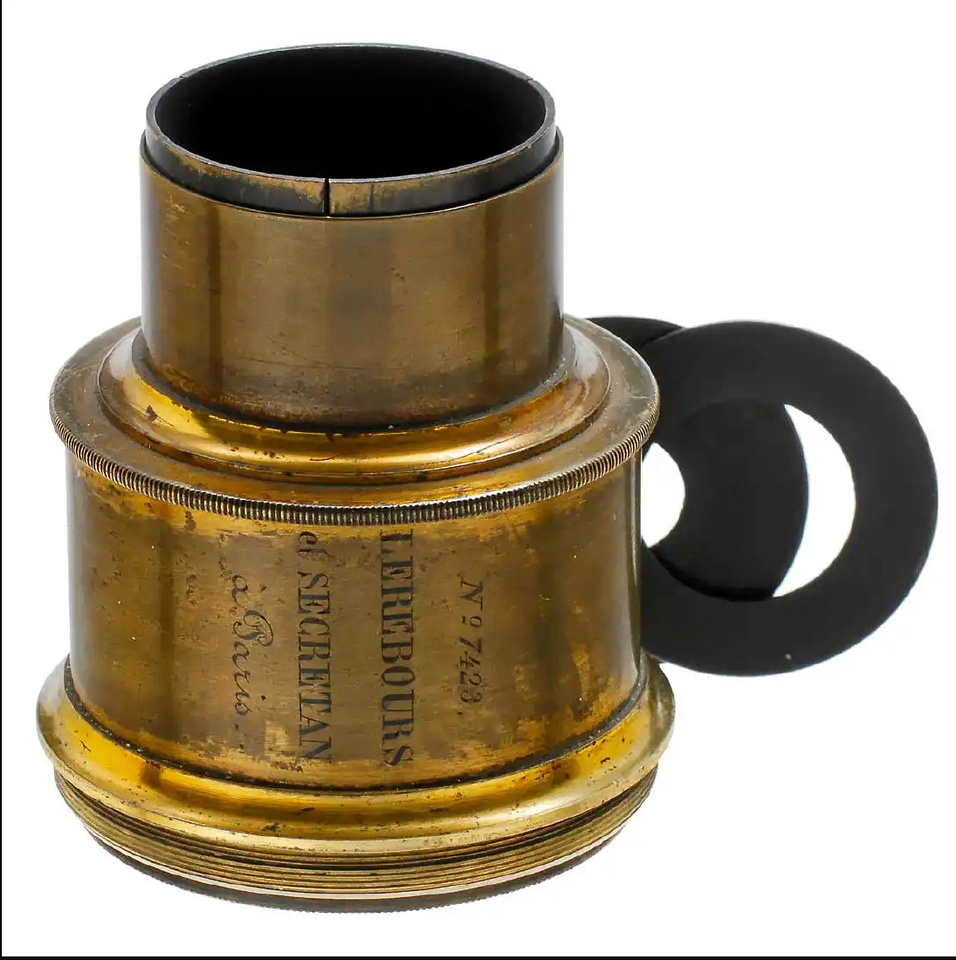Lerebours & Secretan Landscape lens or "Objectif Achromatique" serial #4914
I acquired this LEREBOURS et SECRETAN Landscape lens or "Objective Achromatique" with serial number 4914 in Europe. Sad part is, the barrel was without the achromat lens but for the rest, the assembly was pretty complete. The cup was missing but there were 2 washer stops present with the holder in addition to the built in stop.
Without glass, not a really usable lens but I thought it would still look good on one of my early wooden field cameras from the late 19th century as a display piece.
Lerebours was not only a photographic lens maker but also a photographer from the very beginning. It is written that by 1842 he had made some 1500 daguerrotype portraits.
For those readers that want to know more about Lerebours, Secretan and their lenses and history, please check the publication of Patrice-Hervé Pont and Jean-Loup Princelle, available for sale on the publisher’s website: Le Reve Editions. I also highly recommend the the book on French lenses from C. D’Agostini. (There's also a book out now on early German lenses)
Back to my find:


What caught my eye on this lens is that there was still a lens receiver screwed in the rear. That lens receiver was from a different construction of what I'm used to see; a construction of sorts that captures a glass objective in a case that can be screwed in the rear of the lens barrel.


The outside of the lens receiver is a nicely tapered and stepped design but the inside doesn't have any threads at all. After checking the ID, it turns out that is 85.5mm, so most likely designed to receive an 81mm diameter lens (common size for a lot of lens makers) in some sort of auxiliary and most likely easily replaceable lens mount. It was not uncommon to have replaceable glass with different focal lengths for landscape lenses. There are other possible explanations, we'll just never know for sure unless we find literature on this specific lens design. The first catalog for Lerebours et Secretan lenses was published in 1846.


The image above shows the "lens receiver" unscrewed from the barrel, "inside barrel" portion is the top. No threads at all.
I did find in the parts bin a rear lens receiver from a French nameless brass maker that fits in the LEREBOURS et SECRETAN
landscape lens, and a perfect match for a 81mm diameter objective. This saved me from turning an adapter on the lathe to mount a lens in the unit.
Luck had it that few months later I came across a Lerebours front achromat mounted in British brass. Lerebours name was pencilled on the edge and the serial number was scratched in the glass, #2964. (Lerebours scratched serial numbers in his lenses for traceability. I've seen other lenses where the barrel serial # doesn't conform with the serial number on the lens.)
It is known and understood that Lerebours would polish lenses and sell them to British photography lens makers who would mount these lenses in their brass under their name.
I now have LEREBOURS et SECRETAN lens with serial #2964, front lens from most likely a Petzval style lens (Objectif double) (~ 1846-1847) mounted in a 1849-1850 Landscape body.
Not perfect, but better than having it all go to waste in separate ways.

 The image above shows the new "older" lens in the rear receiver (unknown manufacturer) and all the other parts that come with a landscape lens of the 1850's. The washer stops are shown with the washerstop holder. The latter screwing in the top of the lens cover. It should be equally clear the holder is just another larger aperture and removing the lens cover (unscrews) reveals the glass, fully uncorked, for soft focus portrait work. This is the reason why so many landscape lenses lost their washers, irises, stop and what not ... to be used a achromatic soft focus lenses in the first two decades of the 20th century.
The image above shows the new "older" lens in the rear receiver (unknown manufacturer) and all the other parts that come with a landscape lens of the 1850's. The washer stops are shown with the washerstop holder. The latter screwing in the top of the lens cover. It should be equally clear the holder is just another larger aperture and removing the lens cover (unscrews) reveals the glass, fully uncorked, for soft focus portrait work. This is the reason why so many landscape lenses lost their washers, irises, stop and what not ... to be used a achromatic soft focus lenses in the first two decades of the 20th century.
After studying the above mentioned literature, I didn't find any Lerebours et Secretan lenses with rack-and-pinion focus adjustment in the serial number range. All earlier serial number Lerebours and Secretan lenses I've seen are either fixed for use in a sliding box camera or are of the sliding lens variety themselves, but no rack and pinion or tangential drive, both methods were known and used early on where control of focussing was a requirement.
The image below is not my lens, taken from an auction website for educational purposes. It shows a similar Lerebours et Secretan lens some 2,500 units later and doesn't sport any focus adjusting ability. Probably a matter of cost point at the time.


Next step is to mount this lens on a Sinar lensboard, take it for a spin and make some 8x10 images.
Cheers !
Rudi A. Blondia